Union Steam Ship Company
– SS Razmak / TSS Monowai 1922 to 1960
Please
Note: Firefox & Google Chrome other search engines may not
suitable
Please
use Internet
Explorer - Google for this page to load perfectly!

Click the logo
above to reach the ssMaritime FrontPage for News Updates & “Ship of
the Month”
With Reuben
Goossens
Maritime Historian,
Cruise‘n’Ship Reviewer, Author & Maritime Lecturer
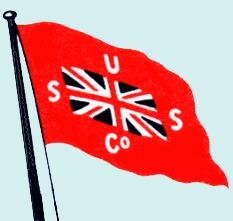
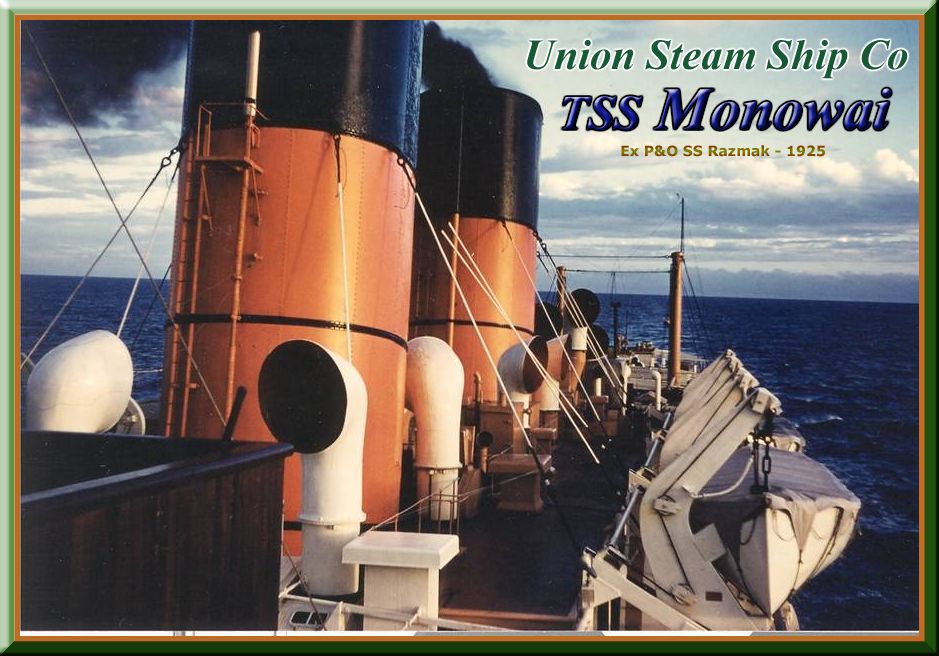
Please Note: Photographs of TSS Monowai, other
ships, interiors & other images are from the author’s private
maritime collection, unless stated otherwise.
Introduction:
Personally I do not feel that the
TSS
Monowai
was the best-looking ship externally, to be honest, myself,
and others used to call her “the ugly duckling of the Tasman Sea.”
However, having been so truthful, the other truth is that the Monowai did prove
to be a superb, a reliable ship, and a fine workhorse. Even though she may not
have been the most luxurious of ships! Yet, over countless years of faithful
service she proved to be an efficient “Express Trans Tasman
Steamer.” In spite of the lack of luxury the Monowai did become such a
loved Kiwi liner by the thousands who regularly sailed on her, for it is not
always beauty that makes the ship, but the feel and the atmosphere of a ship,
for ships tend to have a heart and a soul of their own. Many people think that
such a statement is pure madness, but those who have sailed on classic liners of
yesteryear on many occasions know just what I am speaking about! As you board,
it is like coming home, and there is a feeling if the ship welcomes you! Well
having been on the Monowai many times, I felt just that way!
The Monowai was the complete opposite to the
glamour ships of the Tasman, such as the Union Steam
Ship Co (USSCo) super fast liner and elegant TSS
Awatea and the most beautiful of
ships, the Huddart Parker’s glamorous TSMV Wanganella, both ships offered
the ultimate in luxury. However the latter of these two, TSMV Wanganella and TSS
Monowai did have something in
common, for neither of these two ships were designed and built for the
Trans-Tasman service, but rather for a British company and were to be operated
for a rather staid British market. For interest, both the Awatea and Wanganella
features are also online, see the links at the bottom of this page.
SS
Razmak:
The Monowai was originally built by the famed
Harland & Wolff Shipyards at Greenock
(Yard 659) as a P&O liner. Her keel was laid on June 20, 1923, and she was
officially named as “Rasmak” with an
“S” and she was launched on Thursday October 16, 1924, by Viscountess Inchcape,
the wife of P&O’s Chairman. After the launch, she was towed across
the Irish Sea to Harland and Wolff’s Belfast
yard to have her propulsion machinery installed and to be fitted out. She was
completed in February 1925 she ran her trials in Belfast Lough and accomplished
a speed of 19.8 knots.
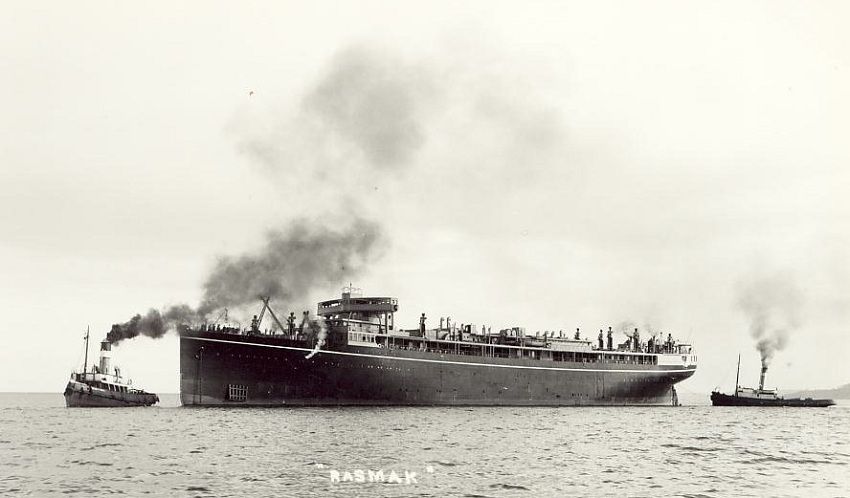
SS Rasmak
seen having just been launched
However, P&O had already decided to
slightly change her name from RaSmak to RaZmak and with her altered name with a “Z”
she was completed and delivered to P&O in London on February 26, 1925 and she
was handed over to Mr Frank Ritchie, who was the joint Managing Director of
P&O. Immediately P&O commenced to make her ready for her maiden voyage
that would in mid March.
The SS
Razmak
was registered as being 10,602 GRT (gross registered tons) and accommodated 142
First Class passengers, as well as 142 in Second Class and 108 in that humble
Steerage section of the ship! In addition she was able to carry a considerable
amount of cargo which was loaded into the ships six holds by twelve hydraulic
cranes, which was quite revolutionary for the times! Her holds were capable of
carrying some 131,460 cubic feet of cargo space. She had two sets of quadruple
expansion engines, each of them turning one of her propellers, developing some
12,000 IHP, giving her a respectable speed of 18 knots. She had six boilers;
four of these were double ended, whilst the other two single ended ones. They
burned oil under forced draught in order to provide steam at 215 psi.
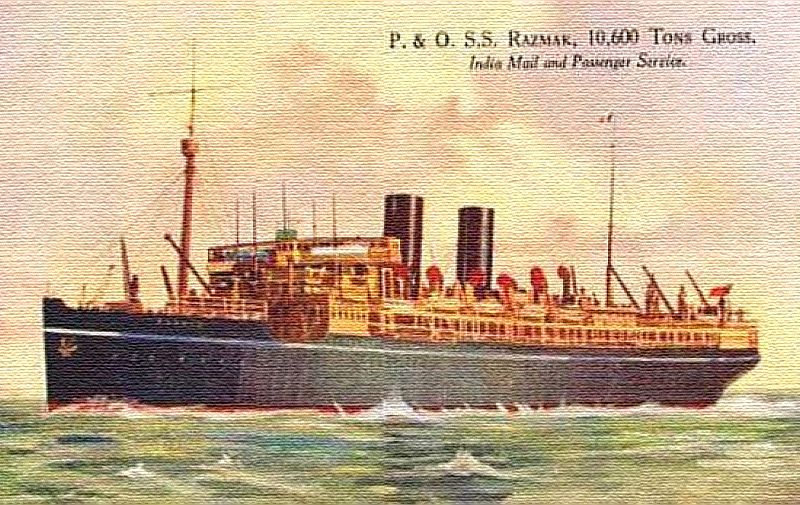
An artist’s
impression of the SS
Razmak
Externally she had that much loved counter
stern, with a long black hull line with a white ribbon, topped by a low slung,
one and a half deck, superstructure that was painted in that horrid
“manila folder” to a “light stone brown” colour, topped
by two tall black slender funnels that were slightly slanted. Her bridge far
forward was a small two-deck structure that stood out, and it did the ship no
favours when it came to her looks, yet there are those that say that she was
attractive. Personally I believe that there were a good number of far more
attractive ships built at that time, and she was certainly not one of them. However
said that, she became a much-loved ship and that is what really counts
here, for she was a most reliable ship when she was in service for her later
owner Down Under, but that story comes later!
SS Razmak
was ready and dressed for her Maiden Voyage from London
on Friday March 13, 1925 bound to Bombay
(India)
with calls to Marseilles,
Suez,
and Aden,
being her designated service. However, a year later, in 1926 she was placed on
the Marseille to Egypt
and India
service, and this would be in cooperation with the British India Steam
Navigation Company. In 1928 P&O decided to give the ship a comprehensive
refit that saw her tonnage change from her original 10,602 GRT to 10,852 GRT
with her becoming a two-class ship.
However, her days with P&O would prove to
be very short indeed, for on July 18, 1930, the Razmak
was withdrawn from service and she was laid up at Tilbury and placed on the
market, but sales would be very slow in those days! Thus her future looked
quite unsure considering the economic situation at that time.
A Transfer was due for the Razmak:
However there was good news was
on the horizon for the Razmak, which came entirely
due to the demise of another fine passenger liner. The Union Steam Ship Co
based in New Zealand, but part of the greater worldwide P&O group, had just
lost their beloved veteran liner, the SS Tahiti, which was due to a freak
engine room accident located some 400 miles (643.73 Klm)
off Rarotonga in August 1930 Obviously her loss left a big gap in the companies
busy Trans-Pacific schedule and thus they were in great need to replace her as quickly
as possible.
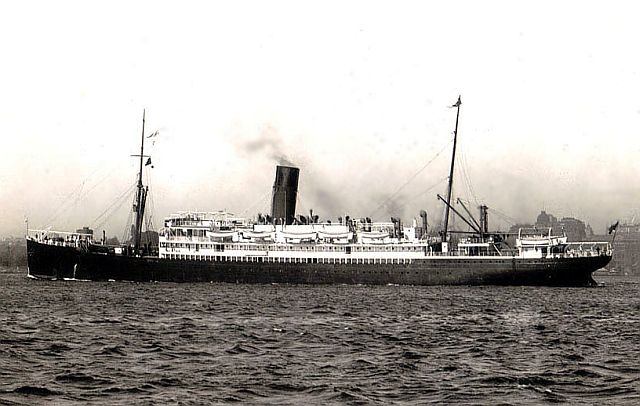
SS
Tahiti seen during her better days
The SS Razmak
being available, she was the perfect replacement, thus she was officially transferred
to the USSCo in August 1930 and she was renamed Monowai making her the second
ship to carry this much loved name in New Zealand for it means “One
Water” in the Maori language. Also, considering the Razmak’s
previous service, having sailed in the warmer climates, she would need very few
alterations for the tropical waters of the South Pacific, thus she would be the
perfect ship! However, several alterations were made, such as Bauar-Wach low-pressure double reduction exhaust turbines
were fitted to each of her reciprocating engines, with a total output now being
14,740 IHP, giving a maximum speed of 19 knots. Also, her accommodations were
altered to 280 First Class and 203 Second Class.
For interest: The first 3,433-ton, 330ft
– 100.6m long, SS Monowai (I) was built by W Denny & Bros, Dumbarton,
Scotland for Union Steamship Co, Ltd, Dunedin in 1890, but she was finally sold
to be scuttled near Gisborne Harbour as a breakwater
in 1926. She had triple expansion engine and single screw made a good 13 knots.
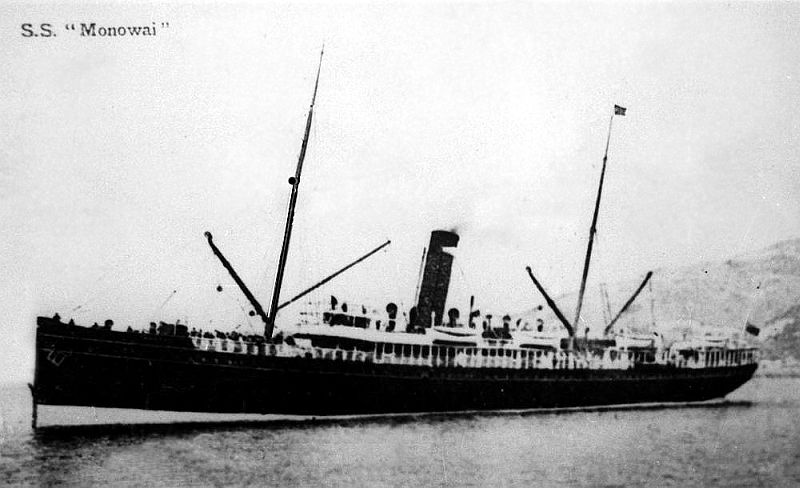
The
1890 built ss Monowai
TSS Monowai:
The SS
Razmak
departed from London
on October 3, 1930, which would be her final voyage as a P&O liner with
passengers on board. She sailed via Gibraltar, Marseilles,
Suez,
Bombay,
and Colombo,
arriving in Sydney
Australia mid November. She then
continued to Wellington
New
Zealand
arriving looking very much the P&O liner in her rather staid livery and
flying the P&O pendant.
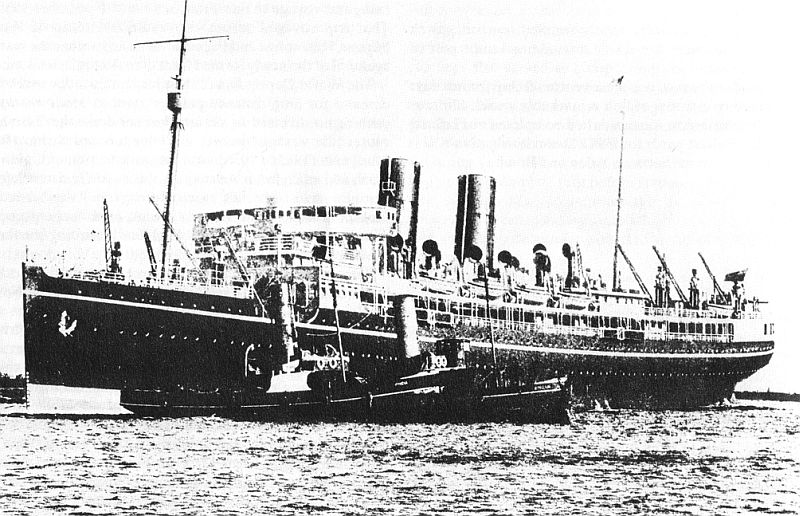
The
newly named Monowai arrives in Sydney
November 1930
Originally copied from a newspaper - from the
author’s private collection
She was given an internal partial
refit and given her new name - Monowai. Some
of the fittings from the companies SS
Mararoa,
which had been laid up in Wellington
for three years, as used on board. Her hull was painted in the Union
company’s traditional Bronze Green, with a white superstructure, however
at first all the ships ventilators were left in the original P&O buff
colour. Her funnels were painted red with black caps. When completed, she
certainly looked a great deal better than she did than she did when she was the
dowdy looking SS
Razmak!
Considering the style of ship she was, she looked quite splendid in her new
livery. Captain A. T. Toten
who was the captain of the lost liner Tahiti, was placed in command of the
Monowai.
Interior Mini Photo Album – the
1930s
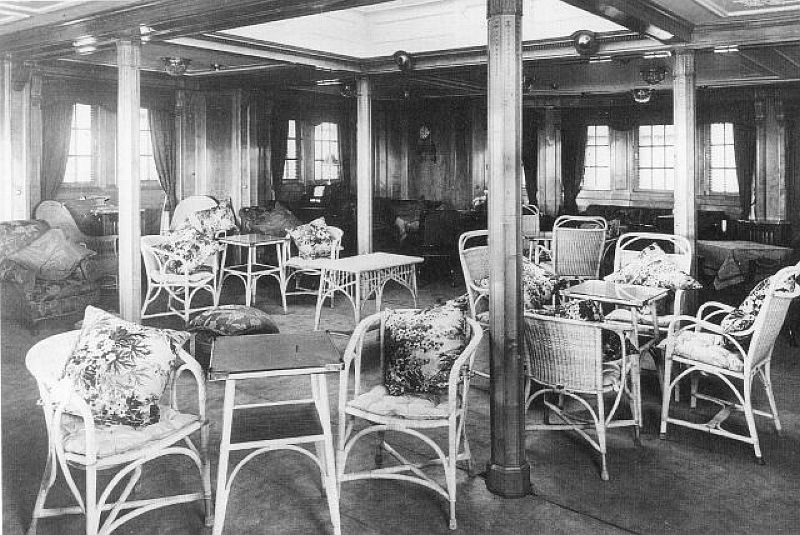
The First Class
Lounge had both a casual rattan stay in the middle, and the more traditional
heavy sofa’s lining the walls
The
walls were clad with dark walnut timbers and the windows had heavy drapes
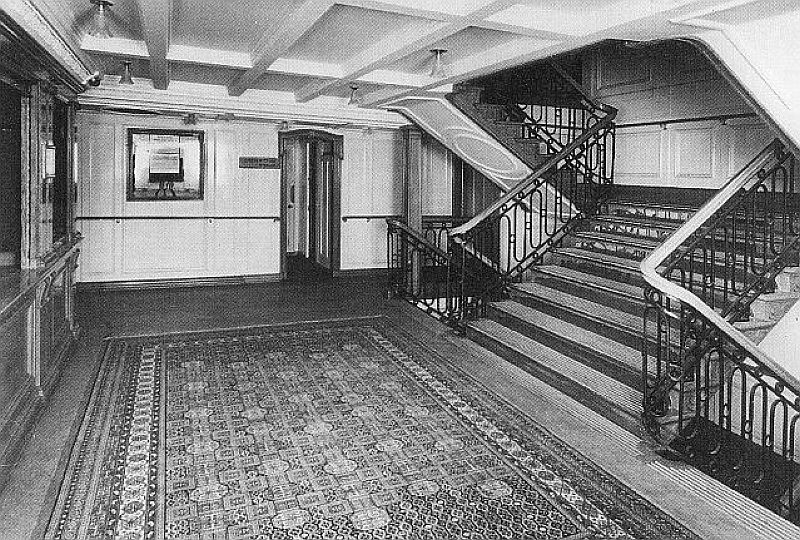
The
forward stairwell was quite splendid and featured large Persian rugs and facing
the stairs timbered walls with large mirrored features
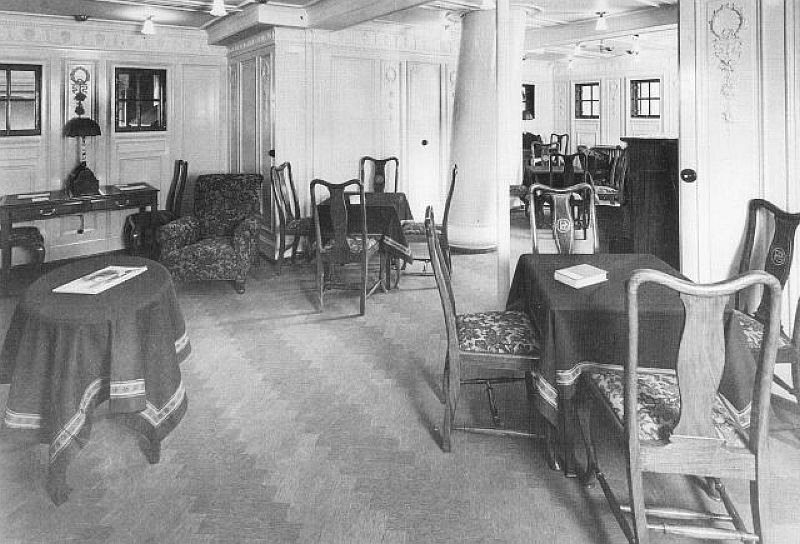
The
Cabin Class Lounge was much brighter and in many ways very smart and
comfortable indeed!
Trans-Pacific Service:
And on December 2, 1930 the SS
Monowai officially commenced her first Trans-Pacific voyage, sailing via
Sydney, back to Wellington (thus also offering a return or one way Trans-Tasman
passages),then to Rarotonga, Papeete to San Francisco and return via the same
ports to Wellington and Sydney. The Monowai had been placed under the
management of the newly formed Canadian Australasian Line.
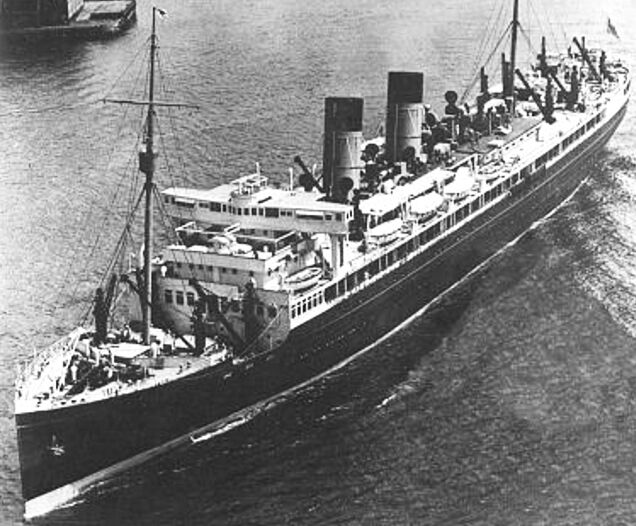
TSS Monowai
seen arriving in Sydney
in the 1930’s
However, the SS
Monowai in comparison to her main rivals, being the
glamorous, much faster, and larger Matson Liner’s the SS
Malolo
and Lurline, the Monowai looked
very dated and her interiors as well as her facilities looked rather tragic and
very out of date, if not ancient! If anyone had sailed on one of these ships
and boarded the Monowai, they would have thought they had stepped back into
ancient history, such as the 1800s! She became known as the “Ugly
Duckling of the Pacific” very quickly and she did not prove to be very
popular, like the SS Tahiti was!
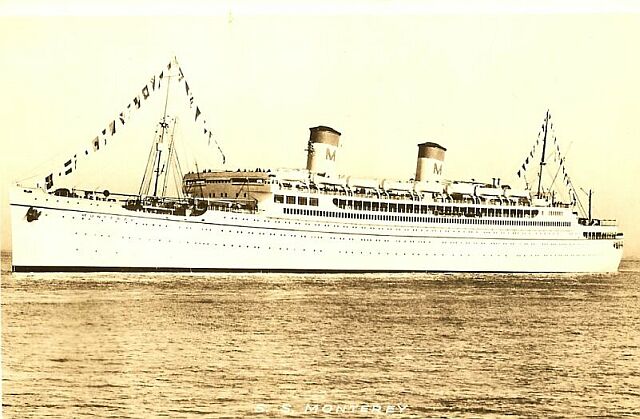
This
is just one of the luxurious grand 20,000-ton Matson liners, and the super fast
and glamorous Australia Awatea would follow in 1936!
With the Monowai sailing on the
company’s regular trans-Pacific run, between Wellington
to Vancouver,
it was decided to replace her with the SS
Maunganui
on the run in 1932. She departed on her first voyage on November 24, that year
and continued to operate on this service together with the SS
Makura.

The SS
Maunganui
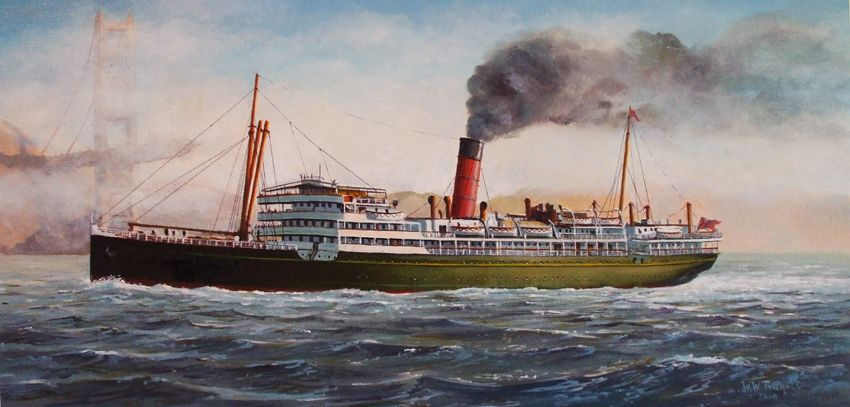
A
painting of the SS
Makura by
Wallace Trickett (NZ)
Enter Wallace’s website HERE
In the meantime the Monowai was placed on the
popular and busy Trans-Tasman service, between Wellington and Sydney, as well
at various times, Auckland Sydney, or even Melbourne would be included at
various times.
There was one thing for certain the TSS
Monowai was a solid and a most sturdy well built ship, for she survived many
years on the high seas, let alone World War II, without sustaining any severe
damage. One of the worst things to ever happen to her was during a summer
crossing from Sydney
to Wellington
in 1934, when a severe storm was encountered. Apparently it was at least a
force-eight Southeast gale, one of the worst storms heard off in at least 20
years, just off the New
South Wales
coast. The Monowai battled the storm for some 24 solid hours, taking on huge
seas that roared high over her bridge and the waves were so powerful that they
smashed a good number of forward to midsection superstructure windows of cabins
and public rooms and thus it saturated many of the cabins and other public
facilities and this left the ship in a terrible mess. The crew had a huge job
on their hand cleaning up and making the ship clean and fit to move around in
and the windows reasonably closed up again! Unbelievably, on the passengers
list on this very voyage was no other than Mr.
Alexander Shaw,
who was the new chairman of the Union Steamship Company.
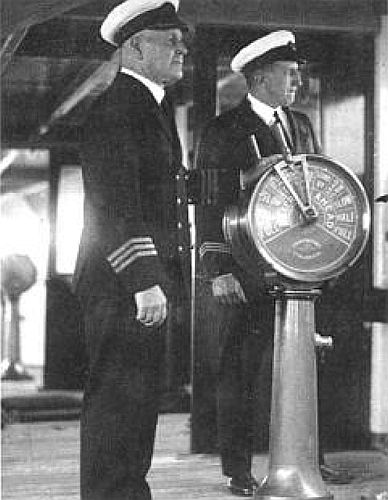
One of the
Monowai’s well know and honoured Captain’s Arthur
Davey
Who received the
Finnish honour of the “Knight of the White Rose”
Later the Monowai was also involved in a
medical emergency after receiving a radio message that one of the cadet’s
aboard the Finnish Sailing Vessel and training ship, the “Favell” was stricken with acute appendicitis. Thus,
the Monowai altered course and met the Favell and had
the cadet taken on board through one of the gun-port doors. She then sailed for
Wellington
where the cadet was treated at the Wellington
hospital. Monowai’s Captain, Arthur
Davey was awarded the honour of the
“Knight of the White Rose” by the President of Finland for his
services at a later date!
A Disappearing Yellow Hull
Ribbon in 1933:
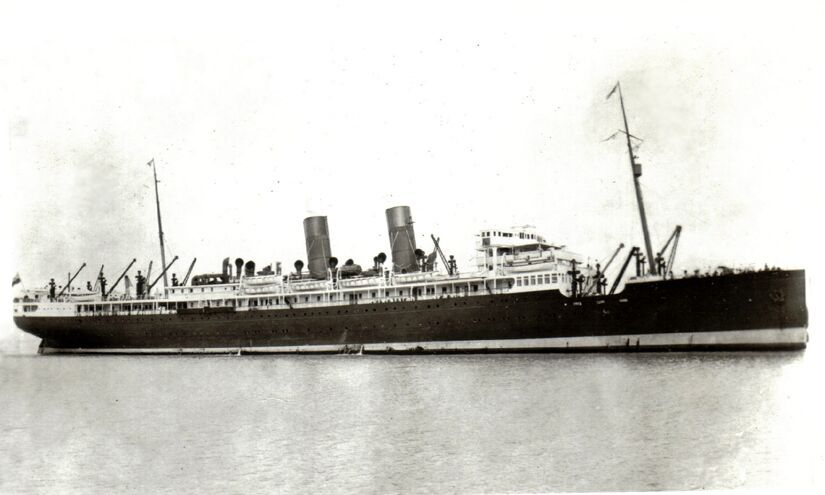
TSS
Monowai seen in 1933 – For some reason during that year that famed USSCo
yellow hull ribbon had been removed, but thankfully it returned by 1934
Image from an unknown source – Please see photo
notes at the bottom of the page
For some reason by 1933 the
yellow ribbon around her hull had gone, and I cannot find any reason for this,
but it was back on her hull in 1934. The only reason I became aware of this was
due to a number of photographs I had seen, such as the one above that shows her
in 1933 and the Wellington
storm image below in 1934, we see that the yellow ribbon had returned.
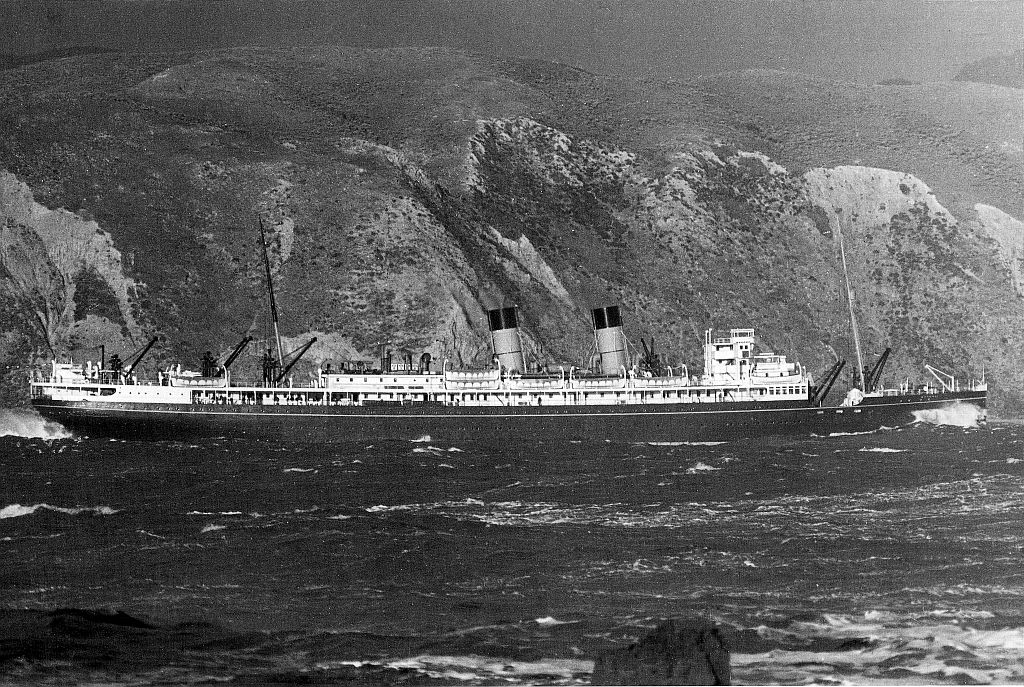
The
Monowai is seen departing Wellington
harbour on May 10, 1934, during one of
Wellington’s
famed southerly gales, with her bow seen ploughing into the waves
Photograph is by courtesy of the “Museum
of Wellington”
Monowai the Cruise Ship:
The Union Lines very first ship to operate
cruises was the SS Wanaka
in 1877 and now the larger and superior TSS
Monowai commenced a Milford Sound
cruise from Wellington
in 1933.
Then on January 8, 1934 a new service
commenced for a New
Zealand ship taking Australian cruise
enthusiasts on the Monowai on a round voyage, thus a cruise to New
Zealand, commencing in Sydney
or in Melbourne
and do the complete Circle-Tasman voyage. This voyage would also make calls to
the Milford
and other the other famous Sounds, which are and remain one of New
Zealand’s
great destinations, giving passengers the opportunity to disembark the ship,
and join a small boat cruise of the region and get close to the native seals,
dolphins and waterfalls, etc. As cruising was more of a tourist venture,
cruising onboard would be a big feature, therefore the catering crew was under
greater pressure than on they would be on Trans-Tasman voyages, and they
ensured that the menus were more elaborate with excellent meals served, as well
with more entertainment being featured.

A photograph of
the TSS Monowai
in Milford Sound just off Mitre
Peak
in 1933
The Monowai had became the very first Union
Steam Ship Company liner to cruise the West Coast Sounds since the ill-fated SS
Waikari in 1910, and she was by the largest ship ever
to enter the Sounds at the time. On the very first voyage was a special
delegation from the Australian “Scottish Union of Victoria” who was
on a “goodwill tour.” Although the cruise was a success, there
was one tragic event at Milford Sounds, when a climber slipped and fell and
injured his spine. He was transferred back to the ship, as there are no
facilities in the region and the Monowai has an emergency hospital for
treatment by the ships doctor. He was stabilised, and the ship sailed for Port
Chalmers where he was taken to the Dunedin
hospital for recovery. As it turned out the ship’s doctor had done
extremely well, and the man came out without any permanent injuries!
However, as time went by passenger numbers dropped
and it had become obvious that the Monowai was not obtaining her passenger or
its cargo quotas, thus she was running very close to making a loss. And thus
and it was decided to cancel her calls at Melbourne purely as an economy
measure, and the company was rethinking its future for at that time the Tasman
traffic seemed to be slowing down for some reason. Yet there seemed to be a
demand for cruises, thus why not explore that, thought the Union Steam Ship
Company?
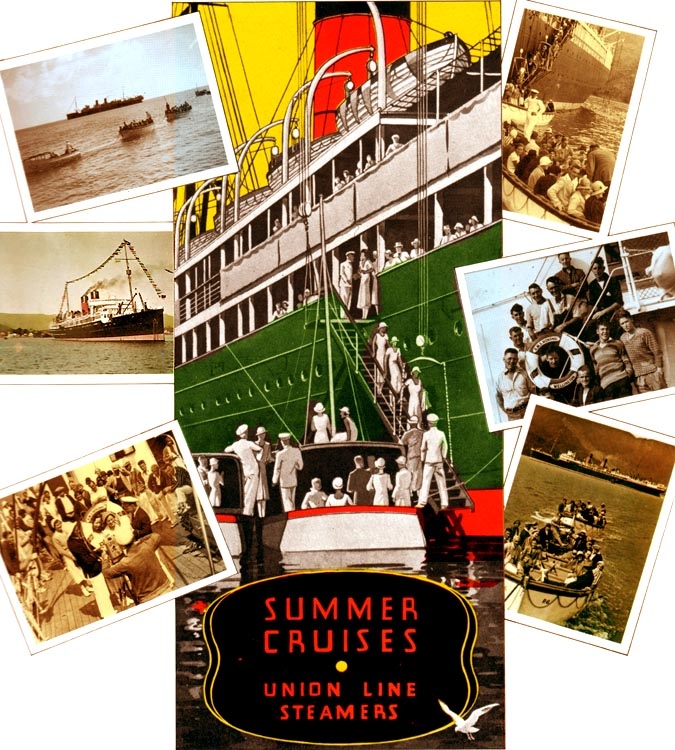
A Union Steamship
Co Cruise Brochure for the 1934/1935 summer season
And that they did for in July 1935, the
Monowai departed a fully booked ship from Auckland
sailing on a two-week South
Pacific
Island
winter cruise. She visited tropical ports such as, Nuku’alofa
- Tonga,
and whilst there HRH Queen Salote joined the Monowai for the
rest of the cruise. The Monowai continued to Vavua,
the next Tongan port of call and the ships master then added an extra surprise
visit to Pago Pago - American Samoa having obtaining
special permission from the US authorities to enter port. The ship did not
actually officially stop there, but she circled the harbour for half an hour
showing passengers the magnificent views. Thus the reason for this special
call to Pago
Pago
was for passengers to be able to see the sheer beauty of this, one South
Pacific’s finest natural harbours. However, there was also something
symbolic about this manoeuvre, for it is one of the key ports on the
company’s rival lines, and this was a port on the “Matson
Line’s” itinerary. The Monowai then sailed to Niuafo’ou, which is also known as “Tin
Can
Island”
where the time-honoured sealed biscuit tins were cast overboard for retrieval
by the swimmers from the shore.
She then headed for Levuka
- Fiji, where Captain Davey managed to obtain great publicity from for Levuka was originally Fiji’s original capital, and it
was also the first port where the ship was able to berth dockside since leaving
Auckland,
and this meant that passengers could walk off the ship, rather than go ashore
in a lifeboat or a tender provided from ashore. Captain Davey had been
told by a visiting dignitary that it was customary for ships “never to
turn their backs on the old capital” and, although this practice applied
only to the local “mosquito fleet of inter-island ships” but with
the Monowai being the largest ship to visit Levuka at
that time, the captain thought to himself, “what a great challenge”
to his ship handling abilities. He took one of the ship’s lifeboats
around the harbour and by the time of the departure, his plans were ready and
made. He set the telegraph astern, and the propellers bit into the water and
the ship moved rapidly backwards across the harbour, the entrance opened up
before the bows. Then a quick ring on the engine room telegraph to full
ahead and the Monowai was heading out to sea and after a short coastal run she
arrived in Suva
the capital of Fiji.
One last day before returning to Auckland,
Captain Davy
anchored the ship in Port Fitzroy and passengers held a special “Farewell
Fancy Dress Ball” on an Island
there. Everyone had a most wonderful evening, although had the captain had the
party out at sea, it might not have been so, for big waves had come up and the
ride for the first time during the cruise was rather rough. But the ball
continued into the early hours of the morning, before the short for the morning
voyage back to Auckland
the seas had calmed. The voyage was a huge success and the Union Line
received many complimentary letters, so much so that the General Manager wrote
a letter of appreciation to the master and crew for “a job done really
well!”
World War II:
The TSS
Monowai continued on her
Trans-Tasman service until the World War II broke out in 1939, when she was requisitioned on October 21, 1939 by the Royal New Zealand Navy and she was refitted
as an armed merchant cruiser (AMC) at Devonport, Auckland.
She was officially commissioned on August 30,
1940 the HMNZS Monowai having a complement of
336. She was equipped with the following armament: 8 x 6-inch guns with 4 on
each side of the ship. 2 x 3 in AA. 6
x 20-mm. 6 x 1 twin 20-mm. She also had MGs
and 8 Depth charges. The ships radar was fitted in June 1942!
While she spent the war primarily working as a troop carrier, the HMNZS
Monowai was armed with eight 6-inch guns, two 3-inch anti-aircraft guns and six
20 mm guns, plus some machine guns and depth charges. Her USSCo engineering
officers were given commissioned rank and remained with her. In addition to
carrying troops the cruiser was assigned to escort freighters, tankers, and
passenger liners between Australia,
New
Zealand,
and Fiji
during the war. Special thanks to
http://navymuseum.co.nz/
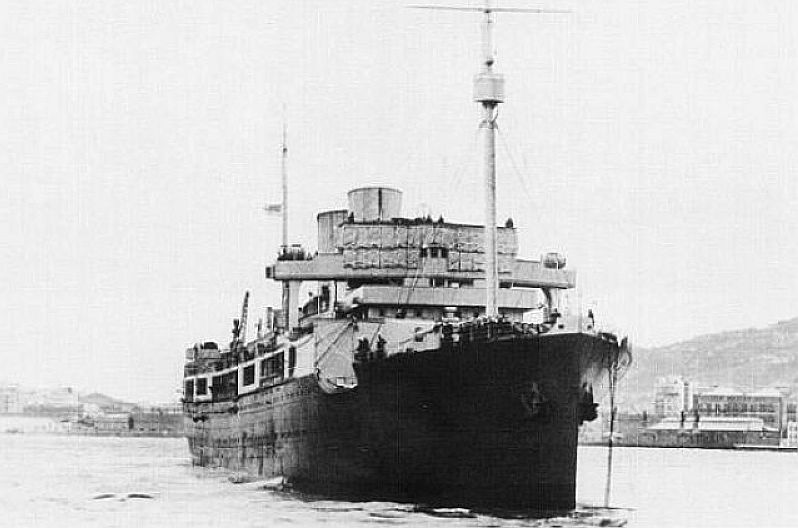
HMNZS
Monowai is seen here as an “Armed Merchant Cruiser” (AMC)
In January 1942 the Monowai was attacked by a
Japanese submarine the 120 whilst escorting troopship HMNZS Taroona just
off Suva.
However, she fought back valiantly firing all her portside guns and drove the
submarine off as her fife was finding range and the submarine rapidly dived.
She then steamed at high speed to avoid the Monowai’s torpedoes. Official
Japanese records prove that the sub 120 fired four torpedoes, but they all
missed their target.
On June 18, 1943, the Monowai was taken over
by the British Ministry of War Transport and she was converted into an assault
landing ship (ASL). Captain G.
B. Morgan
was given command of the now designated HMS Monowai. She would receive yet
another major overhaul and refitting that included installation of defensive
armaments and replacement of lifeboats with 20 assault boats capable of landing
800 troops. Her new armaments were as follows: 1 x 4-in, 2 x QF 12-pdr ( 2 x
1), 2 x QF 2-pdr AA ( 2x1 ), 2 x 40-mm (2 x 1) 8 x RPs
(2 x 4), 8 x 20-mm AA (8 x 1).
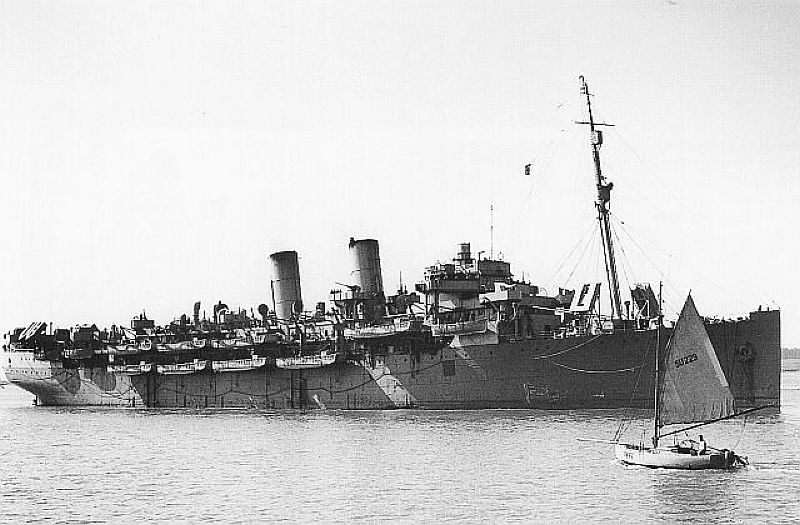
HMS
Monowai now seen as an Assault Landing Ship (ASL)
She was involved in a landing at Taranto
in February 1944, and then she was fully involved in the D-Day landings of June
6, 1944 that delivered some 1,800 commandos to Gold
Beach
during the Normandy Invasion. Of the 20 landing craft that departed from the
Monowai that day, sadly only six returned as all of the others had been
destroyed whilst in combat, mostly by mines during the landing. In 1945 she was
placed on a shuttle service between Southampton and Le
Havre. In
all she made a good 45 North Sea crossings and carried around 73,000 troops to France.
TSS
Monowai and a Holocaust Connection:
Amazingly the Monowai has a
connection to one of the world’s most remarkable WWII stories, it is the
Poignant story of the Dutch Jewish Frank family and their much loved late
daughter who wrote that remarkable and poignant “Dairy of Anne
Frank.” The connection comes via her father, Otto Frank.

Mr. Otto
Frank
Just before the
end of the war in Europe, on April 22, 1945, the TSS
Monowai
sailed from England
for Odessa
on the Black Sea carrying 1,600 Soviet citizens who had been captured
serving with the Germans in France.
The Monowai then embarked many Jewish Holocaust survivors from Western Europe,
including Mr. Otto
Frank, who had been liberated from
the Auschwitz
death camp by the Soviet army. The Monowai departed on May 21 from Odessa
and she arrived on the 27th.at Marseille,
France.
In the book “The Footsteps of
Anne Frank” published in 1959, Ernst
Schnabel wrote the following:
‘The Monowai flew the New
Zealand flag,
and had come all the way from New
Zealand so that
a few survivors from Europe
could return home.' Strangely enough, even though, she had not been
decommissioned yet, but she was already flying the New
Zealand
flag!
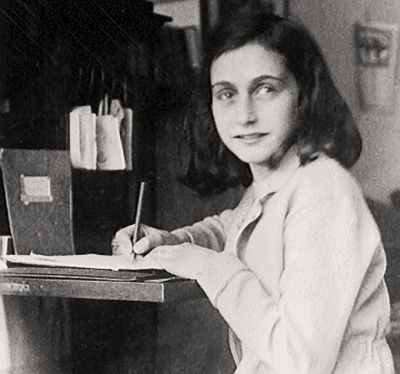
Anne Frank
seen prior to the war
From the record, I am aware that
the men slept in hammocks, whereas all the women were accommodated in
cabins. Apparently according to Mr. Schnabel, Otto was
impressed by the ship’s comfort, especially the abundant food and the
kindness of her crew. However, by this time Mr.
Frank had discovered that his wife,
Edith, had died at Auschwitz,
but to date he did not know anything regarding the fate of his two daughters, Anne
and Margot. On board the Monowai,
he wrote to his mother who was living in Switzerland:
“My entire hope lies with
the children. I cling to the conviction that they are alive and that
we’ll be together again, but I’m not promising myself anything.”
Thus the Monowai will always be
part of an amazing part of history having transported Mr. Otto Frank, who would
in due course locate the most amazing book that would become a sad, but a
world’s best seller, and movies and TV specials would be made to tell
Anne’s and her families tragic story! The book is of course the
“Dairy of Anne Frank.”
Concluding the War Years:
However, there was yet another war going on
further south, much closer to home, and thus the Monowai was being made ready
to participate in yet another invasion, this time it was related to the
Japanese war. However, the Japanese surrendered before the invasion was carried
out, and the HMS Monowai was sent to Singapore
as a “mercy ship.” She returned to England
with some 650-service personnel as well as 199 civilians who had been prisoners
of war. After months of carrying troops back to their homes throughout the
British Empire, the Monowai had fallen in a rather neglected condition and she
was finally decommissioned on August 29 1946 when she arrived in Sydney
and her war duties had finally completed!
During the war years the Monowai as the AMC
guise she had sailed around 121,000 miles and whilst an ASL she had sailed an
additional 140,000 miles. In total she had transported some 105,000 troops,
POWs, as well as civilians, and has been in a number of close encounters, but
survived the war much unscathed, although very worn!
Refitting the Monowai for passenger service:
The Monowai was returned to the Union Steam
Ship Co in September 1946.
The USSCo were at first very reluctant to pay
the cost of refitting this old worn-out ship. But very much like most of the shipping
trade, be it British, or many of the European nations that fought the Germans,
many companies having lost ships and a severe lack of ships available at the
end of the war, the company soon changed their mind and the work was undertaken
at a cost of around a million pounds. The work would be undertaken in Sydney
Australia at Mort’s Dock
& Engineering Co, Ltd and they soon began the modernisation of the old worn
out girl in October 1946.
Changes to her would be as follows: Her main
mast with the hydraulic cranes had already been removed during the war and now
in their place were two sets of twin king posts with derricks. Whilst her far
forward, her well deck had had been closed in, which some did not approve off,
but personally, I feel that it made her look far superior. Also her funnels
were enlarged by cutting them lengthwise and inserting new sections and welding
them together, and now rather than being slim and round the were more
elliptical in shape. As far as her superstructure was concerned, parts of her
forward and aft Promenade Deck was now glass enclosed, thus both First and
Tourist had a glass enclosed deck space. She was given six brand new lifeboats
hung on gravity davits. Her interiors were greatly upgraded with better cabins
and lighter and brighter public venues.
Externally there was one other unusual change,
for she had a newly styled bridge, for it now had a curved front added where
the armoured compass platform and wing searchlights were before. The all timber
teak bridge was now varnished in a dark colour giving it that old fashioned
look, yet it did suit this older style ship!
As a two-class liner, each class would have it
own public venues on various levels. The Main Lounge and Smoke Rooms were
located on A (Promenade) Deck. Obviously First Class located forward and
Tourist aft. Both Dining Rooms were on C Deck. First Class Dining Room could
seat 124 passengers, whilst Tourist had 132 seats.
All her cabins were completely new and
upgraded to the current standards to accommodate 181 First Class and 205 Cabin
(Tourist) Class passengers. First Class cabins were located up on A and B
Decks, and Cabin (Tourist) Class were on B aft and C decks.
Her lounges also were had greatly improved
from those pre war, they still retained some of her excellent fine timber
fittings, but they were much brighter and by far more pleasant!
Her tonnage had increased by 185-tons, thus
she was now; 11,037 GRT, and on board there would be a compliment of officers
and crew of 187.
Although USSCo had hoped to have her back in
service much earlier, due to various circumstances, such as delays in her
completion due stoppages and unavoidable delays in obtaining materials, etc, it
would not be until mid January 1949 that she finally ran her sea trails off Sydney
heads.
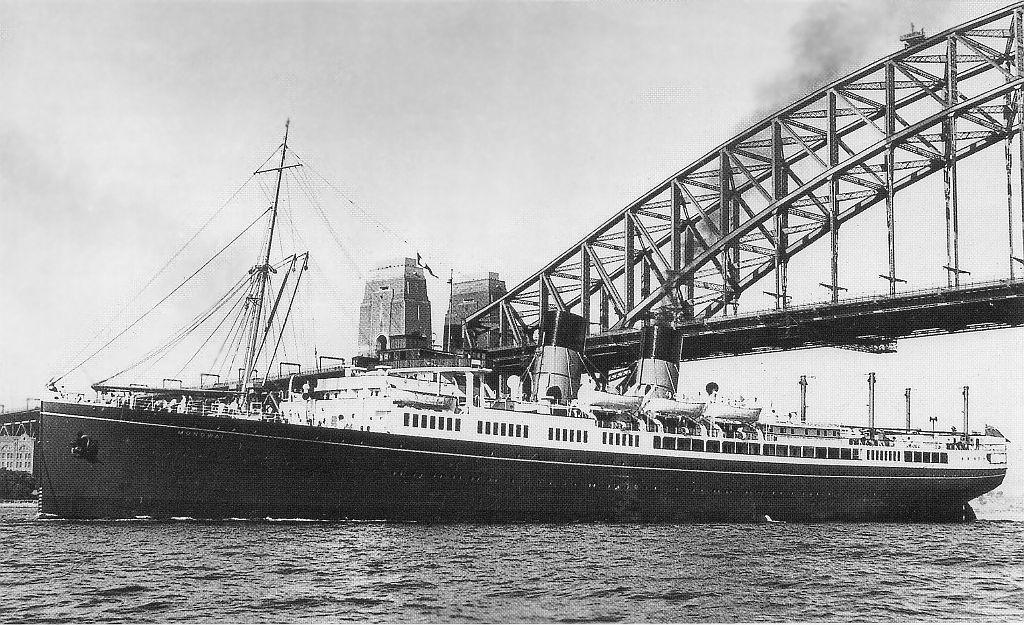
TSS Monowai
passing under the Sydney
Harbour
Bridge
heading off for her sea trails mid January 1949
Having passed her sea trials,
several minor details were attended to, as well a little paintwork, and she was
ready to be returned to her owners.
Interior Mini Photo Album – the
1950s
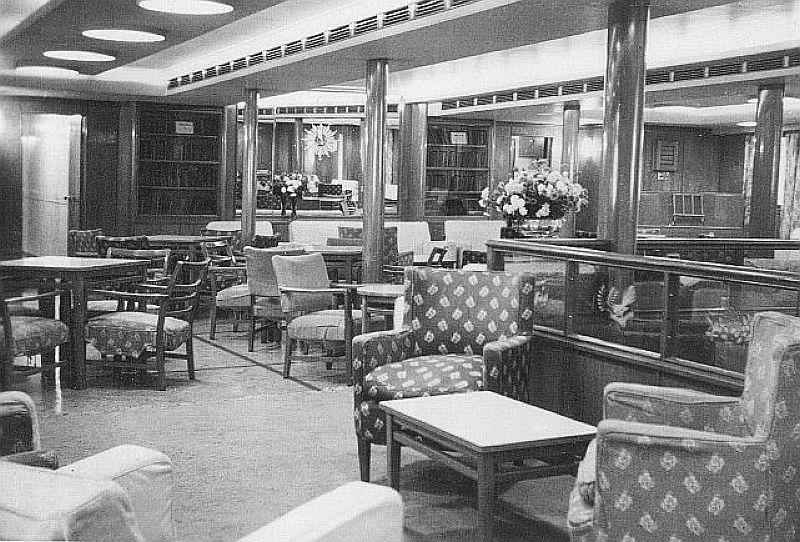
The
First Class Lounge was now by far more luxurious in detail and also more
spacious!
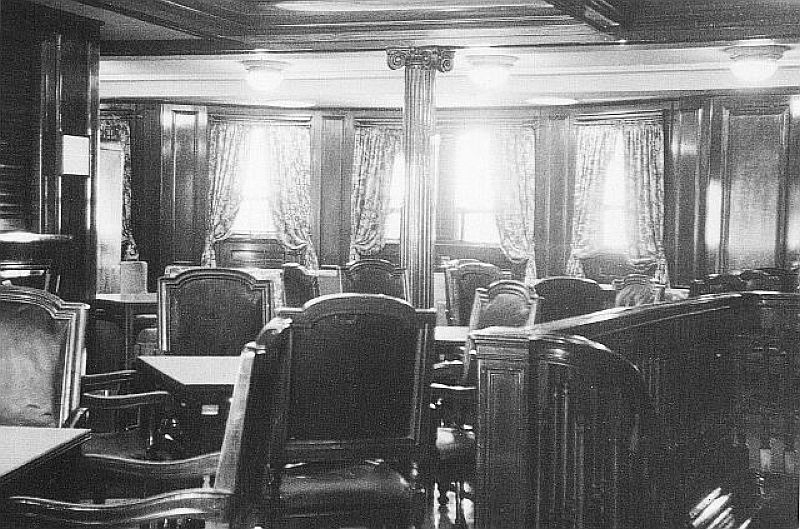
The
First Class Smoking Room retained that traditional timber Gent’s
club feel
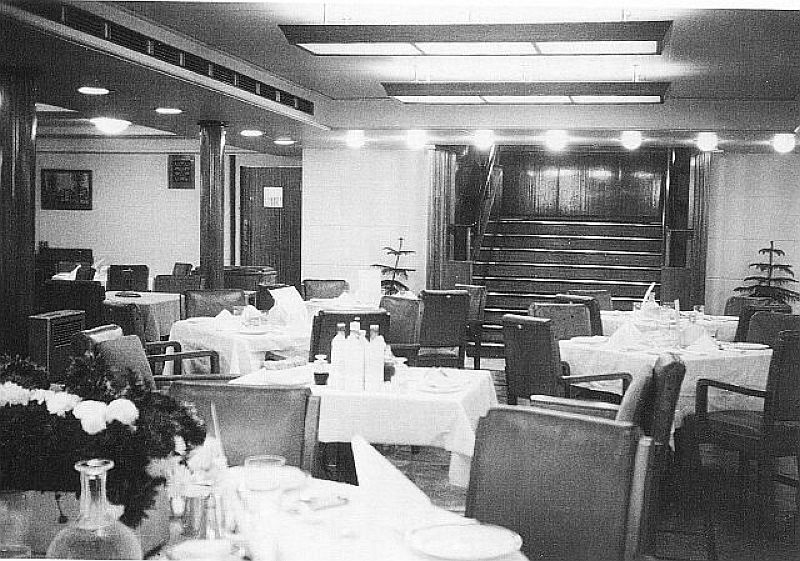
This
is the First Class Dinning Room, which is certainly much lighter that the
earlier version, yet a few of the early timber features remain.
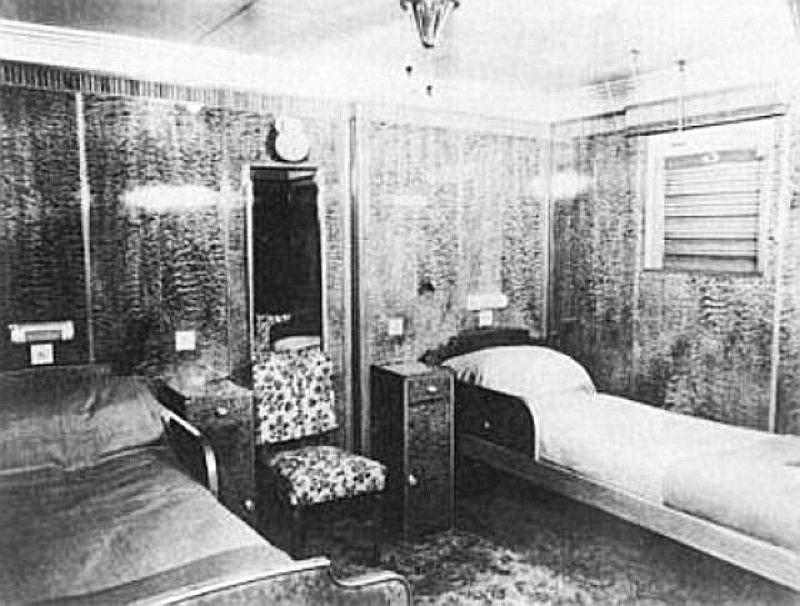
First
Class deluxe Twin bedded stateroom. These rooms were heavily clad in superior
timbers, which was popular those days
a bit too dark these days. Whilst
most other cabins throughout the ship were mostly in lighter painted tones!
Monowai returns to her Trans-Tasman service:
The TSS
Monowai was placed under the command of Captain
G.B Morgan
DSO, DSC, once more, and he would remain in command until this great man retired
late in 1950. Finally after a long ten-year absence, the TSS
Monowai was delivered to the
company (without any passengers on board) in Wellington
on January 27, 1947.
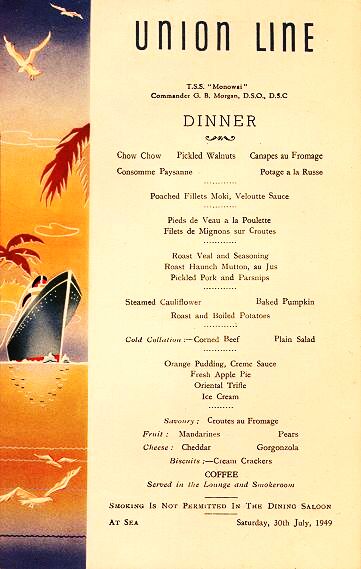
A
First Class Dinner Menu for Sunday July 30, 1949
This was sent in by a relative of a past passenger
However, her very first voyage
had been greatly anticipated and it had been long booked out, thus on the next
day January 28, she departed for Sydney.
She continued on this operation for a good eleven years and sailed in
combination with the TSMV Wanganella.
In 1951 due to a long waterfront dispute in
both Australia
and New
Zealand,
the Monowai was laid up for three months from April
to July. Sadly Industrial conflict was an ongoing conflict of the times and not
just Down Under, but all over the world.
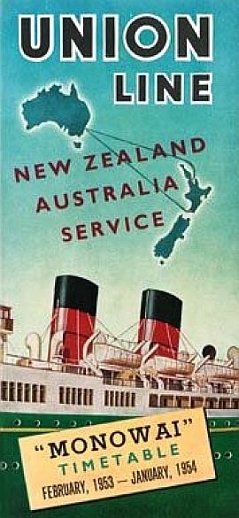
A
Monowai Time Table from February 1953 to January 1954
Although the Monowai operated the Trans-Tasman
from Wellington,
but as can be clearly seen from the schedule above, she now operated a Wellington
and Auckland Sydney voyages. These Trans-Tasman voyages were scheduled as
follows:
Wellington to Sydney
- Sydney
to Auckland
- Auckland
to Sydney
- Sydney
to Wellington
- Wellington
to Sydney,
etc!
Memories from a young male passenger - Master
G. White:
“We had already boarded the
Monowai, and stood up on the deck, and looked down to see our friends, and
there on the wharf at Auckland
were our good friends Mr and Mrs.
Dalguish.
Their parting gift was a small round fruit bowl that was made from a variety of
New
Zealand
native woods. As the Monowai was slowly moving away from the wharf, the band
was playing and there were hundreds of streamers that stretched from the hands
of passengers on board to their loved ones on the wharf, being their last link
as the ship slowly moved away.” Continued below ….
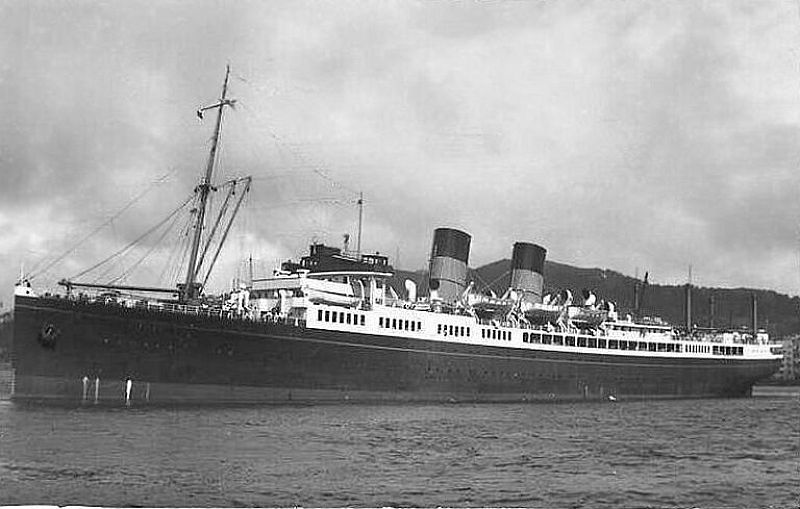
The
popular Union Steam Ship liner - TSS
Monowai
With thanks to the Ian
J. Farquhar
collection
“I remember little about
the actual voyage, except that I shared a cabin with other men and my Mother
with some other ladies. I was scared, but did not cry. I felt that the boat was
very crowded.”
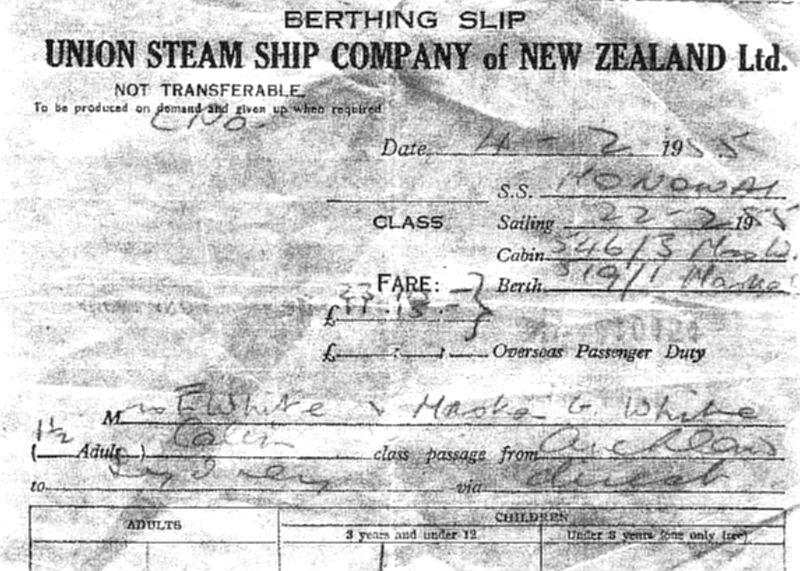
This
is Mr G.
White and his Mother’s ticket
for the Monowai departing on February 22, 1955
I am most grateful to Mr.
G. White
for his contribution to the Monowai feature!
During 1956 she continued the
Trans-Tasman service and I know that she departed Wellington
on Thursday May 10, 1956 crossing the Tasman and
arriving in Sydney
on Monday 14, May, having made an excellent voyage across the
“Ditch”! However, she did operate voyages in order that New
Zealanders could head to the 1956 Melbourne Summer Olympic Games as one
passengers Mr. M. Peden departed Auckland on November
8, 1956 and disembarked in Sydney on November 12, but he headed for Melbourne
to attend the Opening of the Games on November 22, 1956.
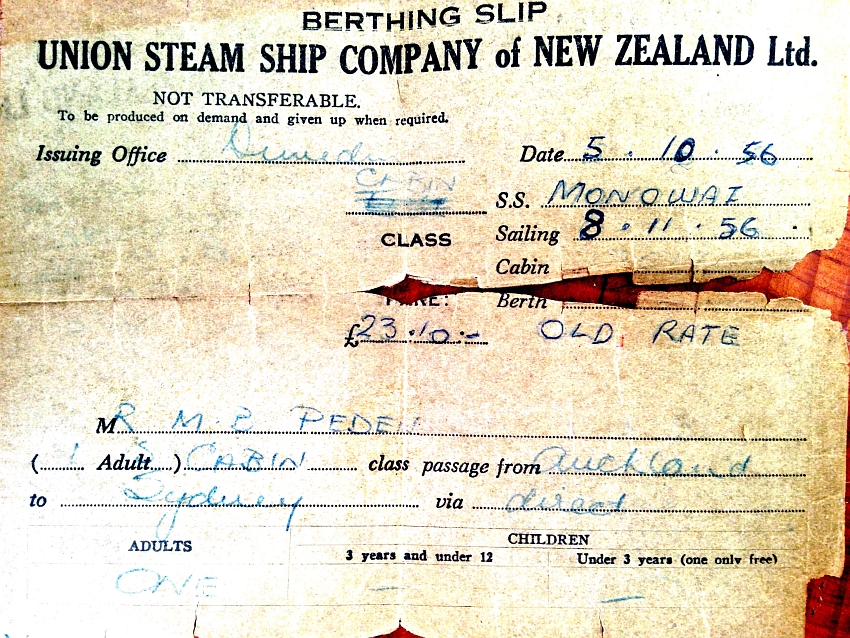
The berthing slip for
Mr. M.
B. Peden
Provided by son Ross
Peden
Monowai: the Cruise Ship:
TSS Monowai
operated some cruises out of Wellington
as well as from Auckland
during the summer months. These cruises varied from short overnight cruises, as
well as two or a three night cruises from wellington they would be to Milford
Sounds, and from Auckland to the Bay of Islands. There were also short cruises
from Melbourne and Sydney,
but there were far and few between.
Let us look at a cruise undertaken in January
1957 she undertook her most popular cruise from Wellington,
being the four-day circumnavigation of the South Island of New Zealand.
Passengers would board the Monowai early in the morning and she would sail
across ‘Cook
Strait’, during the voyage,
passengers had the comfort of her fine lounges, as well as the special
entertainment that was provided, with the band playing in the lounge and even
out on deck. There were sport events as well as many other activities, in
addition meals for cruises were also upgraded! Upon arrival at the southern tip
of the South
Island, the Monowai would enter the
sublimely beautiful ‘Marlborough Sounds’ where she remained for the
night and in the evening there would be a special welcome aboard diner and
party. Departing again early in the morning, the Monowai would be at sea all
day sailing south along the eastern coast of the South Island, giving
passengers a full day to enjoy the comforts of the ship and its many features
and entertainment, etc. Early evening she would arrive at ‘Port Chalmers,’
being the port of ‘Dunedin,’
the only city visited during this cruise, where passengers were able to spend
some time ashore. At 11.59 pm the ship would depart and sail overnight through
‘Foveaux Strait,’ for a morning arrival at ‘Dusky
Sound’ along the west coast, and having visited ‘Dusky
Sound’ the Monowai proceeded through ‘Acheron Passage’
between ‘Resolution Island’ and the mainland, and then sail into
‘Breaksea Sound,’ and then return into
the ‘Tasman Sea’ once again and continued north. The visit would be
to the famed ‘Doubtful Sound’ and then she would head down
‘Thompson Sound’ inshore of ‘Secretary
Island’
before returning to the open sea. The next visit was indeed the main feature of
the cruise being a visit to ‘Milford Sounds.’ She would arrive at
the majestic, but very narrow entry to ‘Milford Sound’ where the
Monowai would sail deep into the sound, with grandiose views of snow capped
mountains high up on the north side and looking east (inland). The ship would
continue down the sound, and pass the famous and spectacular “Mitre
Peak” and continue further ahead until she would have slowly sailed quite
close the famed ‘Bowen Falls’ on the north side of the sound, and
only then she would make a complete turn around and slowly sail through
‘Milford Sound,’ back to the Tasman Sea.
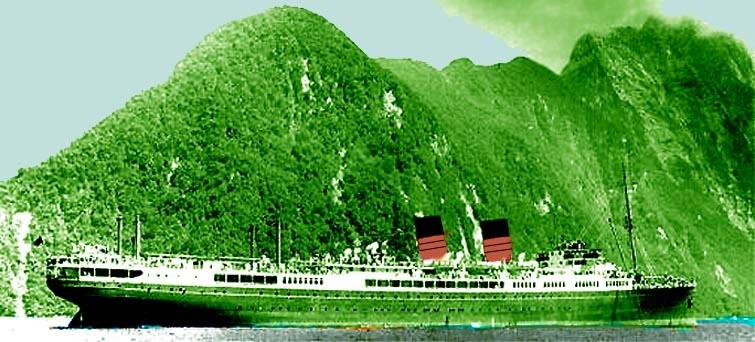
A colourised
photograph of the Monowai seen just off Mitre
Peak
Colourisation by the author of ssMaritime.com - Reuben
Goossens
The circumnavigation of the South Island would
be completed with the voyage up the West coast and round ‘Cape
Farewell’ and she would drop anchor
at ‘Tennyson Inlet’, ‘Pelorous
Sound’, for the Grand Farewell Dance and party on the final evening onboard.
Early next morning the TSS
Monowai return to Wellington,
and passengers would quickly disembark, and she would be made ready for her
next voyage, sailing her next return Trans-Tasman voyage.
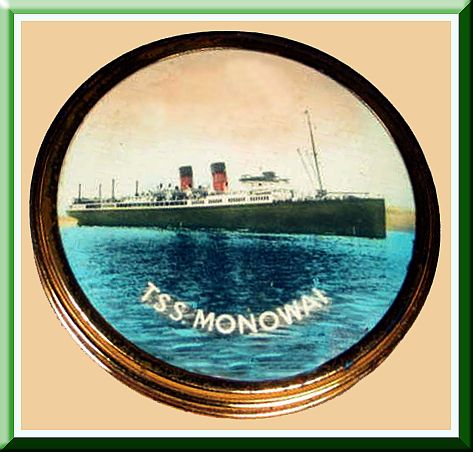
This
a Monowai 1950s ladies powder compact being a typical souvenir was purchased
aboard during a cruise
The 1957 cruise I have detailed above was only
the third ever cruise she had undertaken to Milford Sound since the
1930’s, thus proving that cruises were far and few between, for
principally she was a fulltime Trans-Tasman liner!
1957 also had its Problems:
Having long returned to service and she was
struck by further problems, when on April 11, 1957, just prior to her departure
all passengers were provided with newspapers that stated “The
Monowai’s crew refuses to man the ship.” Thus the USSCo were forced
to withdraw the ship for the time being, which cost them a fortune in lost
revenue! When she did return to service, it became obvious that passenger
numbers were declining, due to various reasons, including the new fad of air
travel across the Tasman.
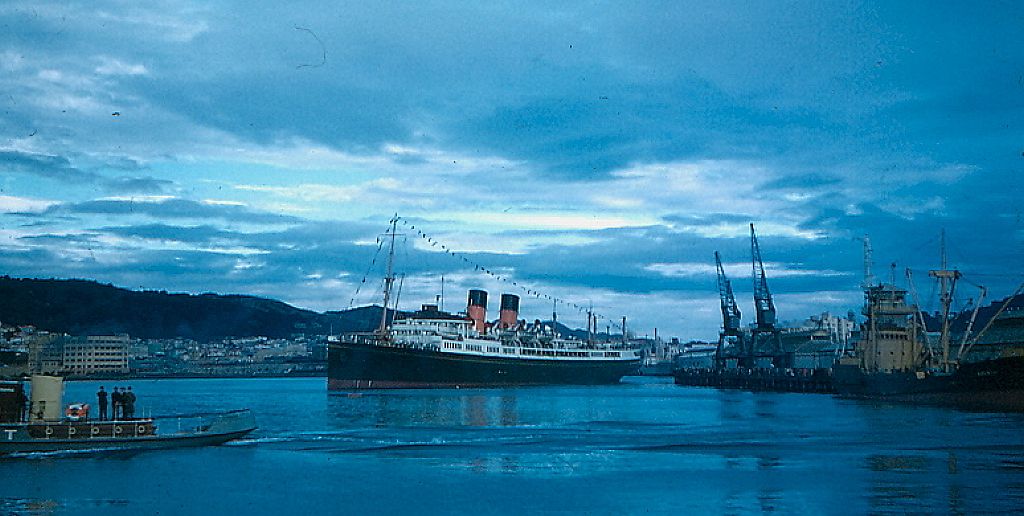
A
delightful photograph of the Monowai in colour seen in Wellington
Harbour
Image from an unknown source – Please see photo
notes at the bottom of the page
However, the company decided to
improve the ship with an extensive refit rather than worry about the passenger
numbers and entice passengers back to this popular ship. It worked quite well,
as by 1959 passenger occupancy was at least 85%, which was well above the
profit level. However, better still during the summer months she was booked out
and always had a waiting list!
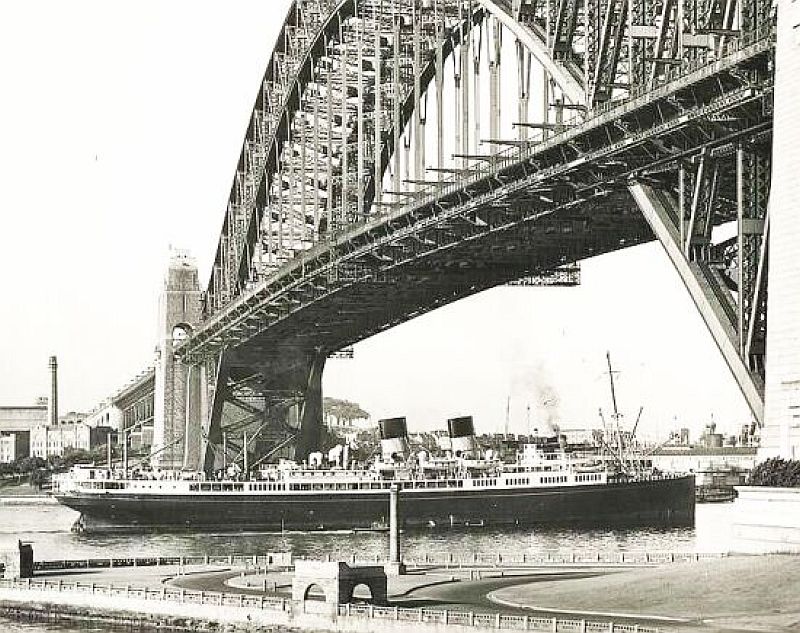
The
Monowai is seen arriving in Sydney
and going under the famed Sydney
“Coat hanger” Harbour
Bridge!
Yet in spite of all this, it was becoming
obvious that there was no real future in passenger shipping across the Tasman,
and the good old Monowai was surely showing her age at 35 years, which was at
least 15 to 18 years longer than most ships of those days would sail. Also her
engines were costing more and more to run and maintain, thus the profit margins
were changing by the day. Thus on November 11, 1959, the Union Steam Ship
Company in Wellington
decided that she would be withdrawn at the end of May 1960. Strangely enough I
would be working with the company several months later and she was still one of
the main subjects of discussions among the staff, who just loved the old girl!
Of course prior to that I had been on board a good number of times and knew her
well!
She departed Sydney
on Friday May 29, 1960, and the shores from Darling
Harbour
to Sydney Heads
were covered with throngs of people bidding the old girl farewell, ships in
port sounded their horns and sirens in salute to a fine ship!
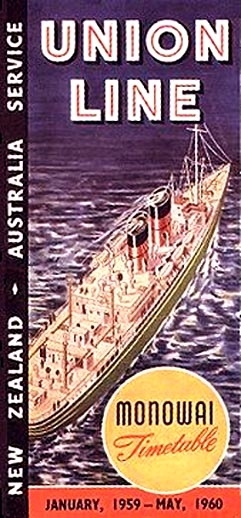
The very last
timetable ever printed for the TSS
Monowai
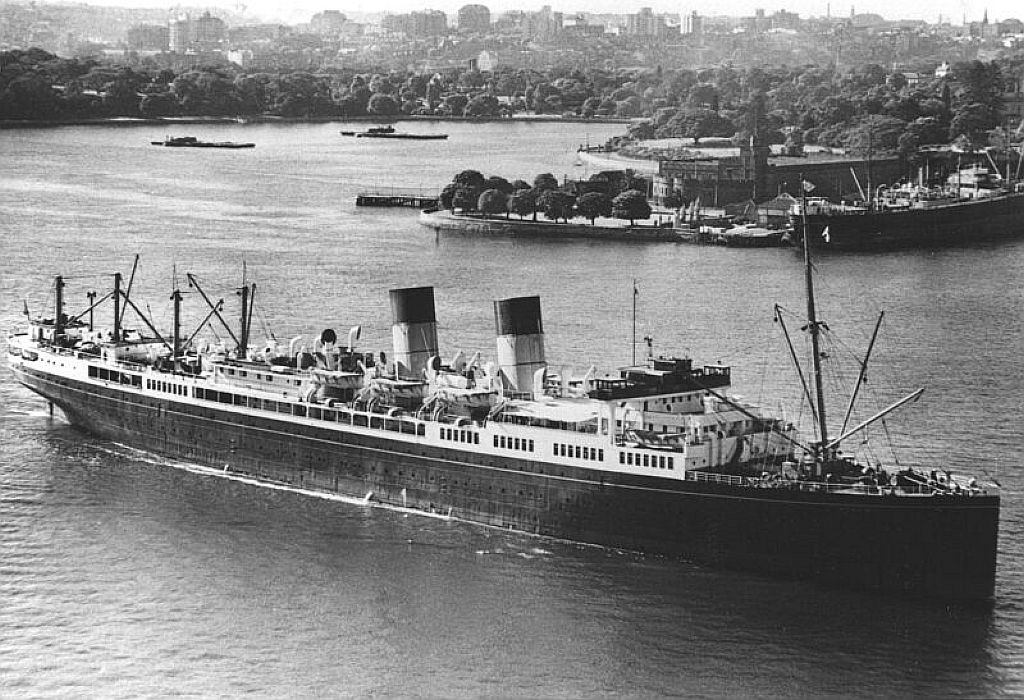
The
Monowai, lovingly known as the “Grand Old lady of the Tasman”
is seen departing Sydney
on May 27, 1960 for the last time
Image from an unknown source – Please see photo
notes at the bottom of the page
She sailed across the Tasman for
Auckland where she arrived on Tuesday May 31, 1960 and she departed two days
later on Thursday June 2 for an 18 day South Pacific cruise, visiting ports
such as Fiji, Samoa and Tonga, ports were she was already well known, but in
her earlier guise, when she was sailing on her Trans-Pacific voyages in the
early 1930s. She returned to Auckland
on Sunday June 19 and her final paying passengers with great sadness
disembarked!
That afternoon and into the evening a special
farewell reunion was held for her wartime crewmembers on board, and it was a
very special occasion for everyone! Then at 10 PM, The TSS Monowai departed and
she headed for Wellington
slowly sailing via the East Coast of the North
Island,
arriving at Clyde
Quay
Wharf
in Wellington
on Sunday June 22. Over the next few days slowly all-important items were taken
from the ship, and she was almost stripped of all her belongings. When finished
Captain Young,
who was in command at the time left the ship, and so did the crew who were paid
off as per custom. The very last person to leave the Monowai was her carpenter Mr.
W. Hendry,
as he had joined the Monowai in 1949.
The Monowai had already been sold to the Far
East Metal Industries and Shipping Company of Hong
Kong, whose intension was to have her
broken up. However, once the ship had been signed over, she remained at her
wharf for six and a half weeks, then finally on Monday August 15, 1960 her
engines were firing up and smoke emerged from he funnels and she was ready for
departure. She had British Hong Kong based captain and officers and some 50 Chinese
and European crewmembers. I recall, it was one of those typical Wellington
days, windy (a northwesterly) and wet, as I watched
her lines go at 1500 hours (3 PM). I recall many of her past crew were watching
her go and they removed their hats looking rather sombre, as was I, for she had
been a stalwart of the Union Steamship Company and I worked for the company at
the time.
Then. as she moved slowly away from the wharf
she sounded three short blasts from her steam horn and this was answered by
every single ship and vessel that was in Wellington
Harbour.
As she steamed away and round the Harbour, she was making black smoke and she
slowly disappeared as she turned to starboard heading out through the entrance.
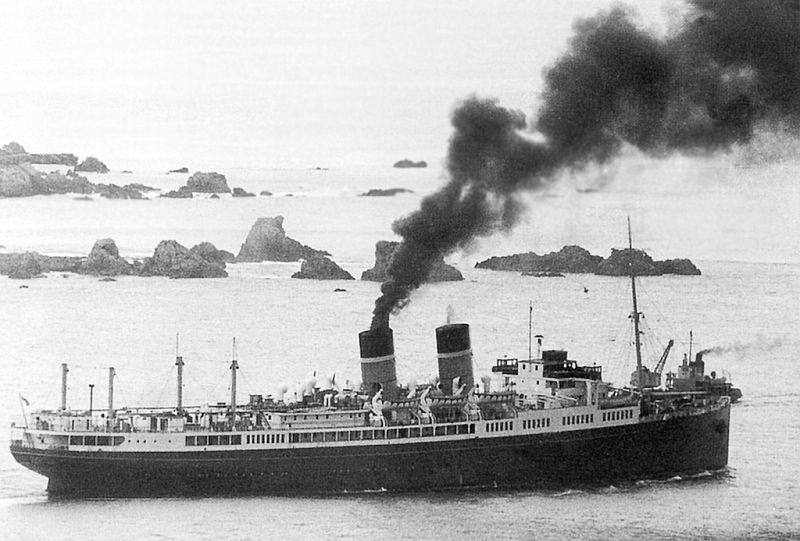
The
sad departure that I witnessed from wharf level on Monday August 15, 1960
Photo obtained from the NZ “Dominion Post” in
1960, and has long been part of private my collection
Once the Monowai had sailed
through Wellington’s
“Entrance” she would then sail westward into the Tasman Sea for her
final voyage to Australia
as she was heading for my future home port
of Brisbane where she would bunker,
taking on fuel, She arrived in Brisbane
on Saturday August 20, and as soon as bunkering had been completed she departed
and sailed north heading directly for Hong Kong.
Sadly it would be within just three and a half
short weeks that her engines would be shut down and recorded as being “Finished
with Engines.” The neat and tidy looking ship, with her paintwork being
close to perfection, the new white line
around her funnel between the red and black tops looked just fine, in fact she
looked more like she was about to commence a brand new cruise service.
But, sadly that was not the case, for the
Thirty Six year old TSS Monowai arrived at the Hong Kong ship breakers on
September 13, 1960, and as they were finished with her engines, the captain on
the Bridge rung “Finished with Engines” for the very last time, and
breaking up of the ship commenced almost immediately.
Specifications:
SS Razmak:
Built: Harland
& Wolff Shipyards, Greenock,
Scotland.
Yard: 659.
Laid Down: 1923.
Launched: October
16, 1924.
Tonnage: 10,602 GRT / After a 1928 refit 10,852 GRT.
Length: 158.2m / 519ft.
Breadth: 19m / 62.3ft.
Draught: 7.9m / 26ft.
Engines: Combination quadruple
expansion engines by her builder, but in Belfast.
Screws: Two.
Service
speed: 18 Knots.
Maiden
Voyage: March 13, 1925.
Passengers: 142 First
Class, 142 Second Class and 108 in Steerage.
Laid Up: July 18, 1930.
Modifications: Bauar-Wach
low-pressure dble reduction exhaust
turbines to each of her reciprocating engines IPH - 14,740.
Speed: 19 knots.
Departure: October 3, 1930.
TSS Monowai: “Grand
Old lady of the Tasman”
Tonnage: 10,852 GRT / 11,037 GRT from 1949.
Engines: Combination quadruple
expansion steam engines, & Bauar-Wach low
pressure turbines IPH 14,740.
Screws: Two.
Service
speed: 19 Knots.
Maiden
voyage: December 2, 1930 from
Wellington,
via Sydney
to the USA
and back.
Service: 1930-1932:
Trans-Pacific service.
. The
balance of her passenger career: Trans
Tasman service & the occasional
Pacific cruise.
Wartime
duties: HMNZS
Monowai from October 21, 1939 to June 18, 1943, when she became the HMS Monowai.
Decommissioned: August 29, 1946 – Refitted in Sydney
completed in 1949.
Passengers: 280 First
Class, 203 Second Class until 1939.
Passengers: 181 First Class, 205 Cabin (Tourist) Class from 1949.
Crew: 180.
Passenger
Decks: Five.
Headed for the breakers: August
15, 1960 sailing via Brisbane, Australia
to Hong Kong.
Arrived Hong Kong: September 13, 1960 to be broken up.
Memories of a much-loved Kiwi Liner the …
TSS Monowai
“Grand Old Lady of the Tasman”

With thanks to the Ian
J. Farquhar
collection
Above: The popular New Zealand Liner – T.S.S.
Monowai seen in Wellington
Harbour
in then 1950’s
Below: An excellent stern view of the T.S.S.
Monowai seen toward her final days
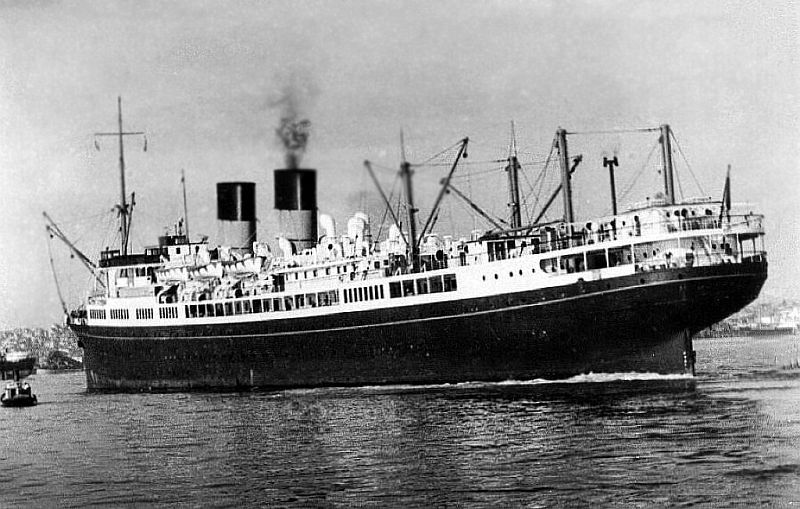
Image from an unknown source
– Please see photo notes at the bottom of the page
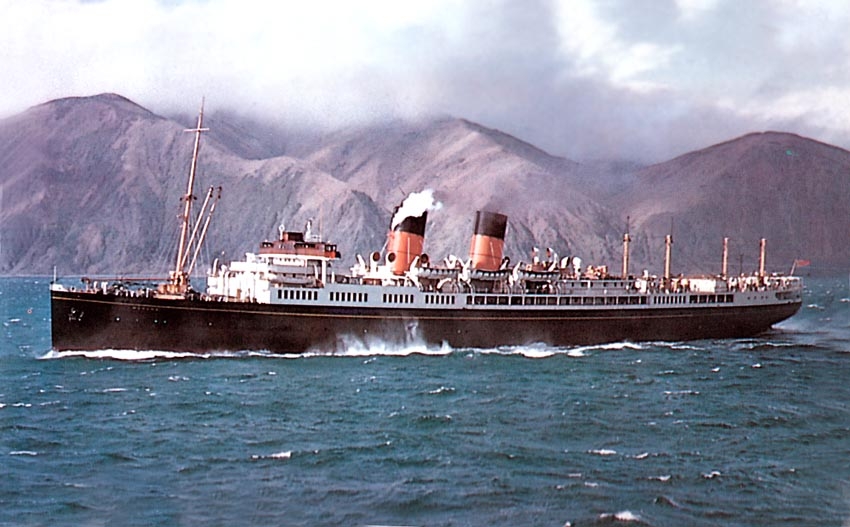
This fine
photograph was taken, whilst she sailed from Auckland
to Wellington
on June 21, 1960
This was her very
last voyage for the Union Steamship Company, as she had already been sold
Photograph released by the Union Steamship company, Wellington
in the late 1950’s
***********************************
Also view other USSCo
Passenger Ships online, from oldest to the last ever built
SS Waitaki / SS Moeraki &
Manuka / SS Marama
& Maheno / SS Tofua
RMS
Aorangi / TSS Monowai / TSS Awatea / MV Matua & MV Tofua
***********************************
Use
the Back button on your browser or Close the Page to return to the previous
page
or go to our ssMaritime INDEX
ENTER
OUR ssMaritime Main INDEX
Where
you will discover over 1,350 Classic Passenger & Passenger-Cargo Liners!
ssMaritime.com & ssMaritime.net
Where
the ships of the past make history & the 1914 built MV
Doulos Story
Photographs
on ssmaritime and associate pages are
by the author or from the author’s private collection. In addition there
are some images that have been provided by Shipping Companies and private
photographers or collectors. Credit is given to all contributors. However,
there are some photographs provided to me without details regarding the
photographer/owner concerned. I hereby invite if owners of these images would
be so kind to make them-selves known to me (my email address may be found only
on www.ssmaritime.com), in order
that due credit may be given.
This
notice covers all pages, although, and I have done
my best to ensure that all photographs are duly credited and that this notice
is displayed on each page, that is, when a page is updated!
A Special thanks to http://navymuseum.co.nz/.
ssMaritime is owned and © Copyright by Reuben
Goossens
- All Rights Reserved











































